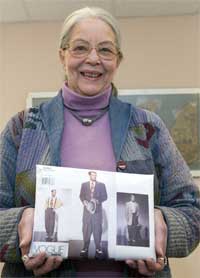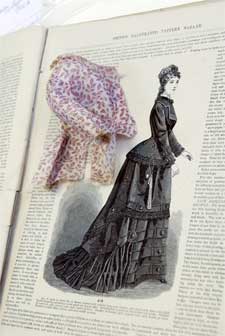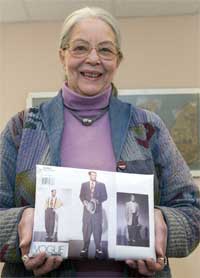 Famous pattern maker donates archive to University
Famous pattern maker donates archive to University
KINGSTON, R.I. — June 5, 2007 — If there was ever any question about whether or not the University of Rhode Island held the largest clothing pattern collection in the world, the latest donation to URI should dispel any lingering doubt.
McCall, which now owns Butterick and the Vogue Pattern Co., has recently transferred all of the patterns in its archive to the URI’s Commercial Pattern Archive. While McCall and Vogue did not archive their patterns, Butterick maintained an archive. The Butterick Archive does not contain a copy of every pattern the company produced, but it does include vintage patterns and a selection of patterns produced after 1960.
Kathleen Lenn, senior vice president of McCall, described the company’s donation goal as a way “to enrich that which is already an outstanding archive in the entire commercial pattern industry, rather than maintain smaller collections of our individual brands.”
Joy Emery of West Kingston, a URI professor emerita of theatre and former adjunct professor of textiles, fashion merchandising and design and curator of the University’s Commercial Pattern Archive, estimates the gift includes more than 1,200 patterns dating from 1871 to 2000.
 One extremely rare pattern in the donated archive is for a bodice produced by A. Burdette Smith around 1875. Rather than illustrating the garment, a 1/8″ scale hand-sewn cloth model was folded in with the full-scale pattern pieces.
One extremely rare pattern in the donated archive is for a bodice produced by A. Burdette Smith around 1875. Rather than illustrating the garment, a 1/8″ scale hand-sewn cloth model was folded in with the full-scale pattern pieces.
“I’ve read about Smith’s cloth models, but have never seen one,” said a thrilled Emery. “It is a real treasure to have in our archive.”
A Zoot suit pattern is part of the vintage costume pattern line for men. Produced in 1999, the suit is based on the jazz culture and associated with a statement on defiance. “I’ve had several requests for a Zoot suit pattern so this is a great addition to our archive,” said the URI pattern expert.
“Commercial patterns present a broad spectrum of everyday dress and provide a significant documentation of American culture,” she said. “Clothes on display in museums are generally high end, couture dress that were deemed worth saving. Clothes made from commercial patterns were often handed down and/or recycled into quilts or rugs.”
Preserving patterns is challenging, considering that full-scale tissue paper clothing patterns are designed to be disposable. In fact, it�s common for pattern companies to contact Emery for a pattern since they routinely destroyed their outdated patterns.
For the past dozen years, Emery and a cadre of volunteers and student workers have scanned the front and back of more than 31,000 pattern packages in the URI collection, which span more than a century –from 1868 to 1990 — into an electronic database. The result is a four-volume CD-ROM set, which can be purchased as a set or sold separately. The first CD covers 1868 to 1944, the second disc covers 1945 to 1956, the third disc covers 1957 to 1968, and the fourth disc covers 1969 to 1978. The discs can be purchased for $100 each or the set for $360. A user manual is available for $15. Emery’s team has stopped scanning patterns from the 1980s in order to incorporate this newest collection.
Emery is still bursting at the seams with patterns. She recently archived 150 large pattern sheets that were folded into Harper’s Bazar Weekly (yes, it’s spelled correctly) from 1868 to 1903 as a promotional giveaway. These fragile, double-sided sheets have 20 to 24 patterns superimposed on each other. The patterns, defined with a complicated maze of coded lines, dashes, and stars, are designed to create fashionable garments for men, women, and children, undergarments, doll clothes, pen wipers, lampshades, and other decorative items for the Victorian household. Too large to be scanned, Emery is preserving the 30-inch by 23-inch sheets in flat storage boxes in the archive.
“There is such a wealth of history here. All of the patterns are expressions of their time period and reflect the society that they were made in,” said Emery, noting that theatrical designers, clothing manufacturers, social historians, and museum curators, among others can use the information to recreate a time and place or date clothing in their collections.
Trends can also be traced through the patterns, such as the evolution of pants for women, from bathing suits, to bicycling and other sports activities, to the influence of Hollywood’s silk pajamas.
The retired URI professor was inspired to collect patterns nearly three decades ago, after finding a full circle skirt pattern in her friend’s collection to use for a character in the University�s production of Anne of Green Gables. The friend, Betty Williams, was a New York costumer and pioneer in dressmaker pattern research. When she died, all of her 12,000 patterns were donated to URI, propelling the University into pattern history.
The patterns, which have been designated an official project of Save America’s Treasures by the National Trust for Historic Preservation, represent 60 different pattern companies, and include such high style couturiers as Dior and Vionnet. Women’s dresses, silk bloomers, men’s suits, aprons, masquerade costume designs, and children sailor suits are among the many entries.
The oldest dressmaker pattern in the URI�s archive is a Demorest pattern published in Frank Leslie’s Ladies Gazette of Fashion in 1854. To learn more about the collection, go to: www.uri.edu/library/special_collections/COPA/home.htm
“We’ve begun cataloging the donated patterns and adding them to our database, but it will take a lot of hours to get through all of them. Meanwhile, we are having a good time discovering all the treasures in the collection,” says Emery.
Pictured above
Joy Emery, a URI professor emerita of theatre and former adjunct professor of textiles, fashion merchandising and design and curator of the University�s Commercial Pattern Archive, holds a Zoot suit pattern that the archive recently received. URI News Bureau photo by Michael Salerno.
A rare, hand-sown bodice produced by A. Burdette Smith around 1875 was folded in with the full-scale pattern pieces. The pattern is among 1,200 patterns recently donated to URI�s Commercial Pattern Archive, the largest collection of patterns in the world. URI News Bureau photo by Michael Salerno.

